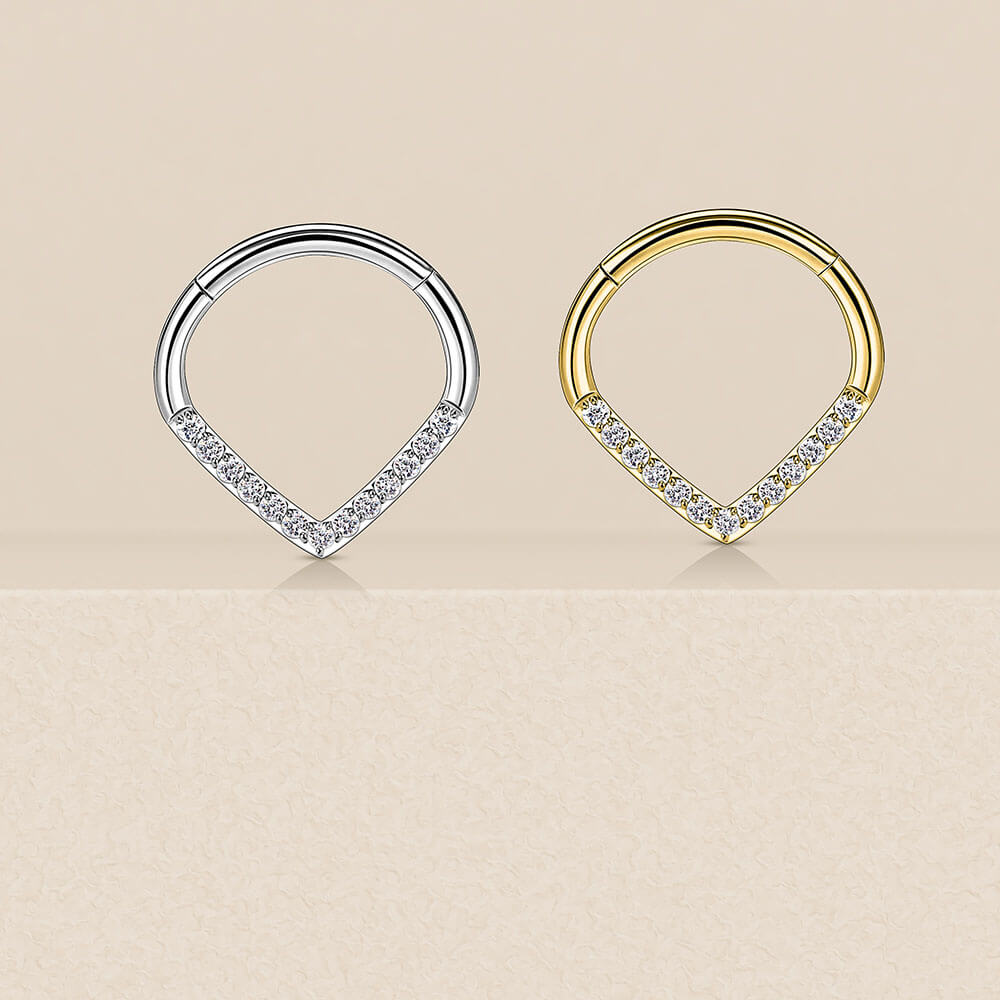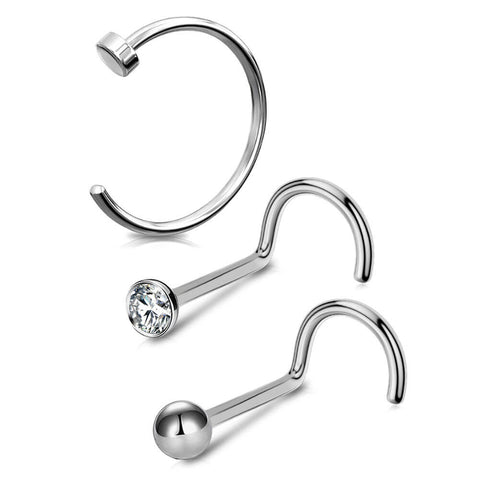
All About Nose Rings: Types and Materials
When it comes to styling, fashion, and jewelry, your entire body is a blank canvas waiting to be decorated. Nose piercings are no exception to the rule and look just as gorgeous as earrings, bangles, and rings. The custom of piercing adornments into the nose has ancient roots in several different cultures across the globe. It is still as alive and popular as ever, even in the 21st century.
Here’s a rundown about the different types of nose rings, the best materials and metals for a nose ring, and different nose piercing jewelry types to choose from.
Types of Nose Piercing Jewelry
There are tons of options when it comes to nose rings. Most of the time, the type, size, and shape of the nose piercing jewelry depends upon the kind of piercing you have. Other factors include how fresh the wound is, the healing curve of the piercing, and of course, personal taste.
Nose Hoops
Hoops are another nose ring favorite often seen on people with nose piercings. Hoops are a subtle way to show off your piercings without going overboard. You can experiment with their different sizes, shapes, and thicknesses.
Nose Studs
Nose studs are a popular choice among men and women. They have a simple structure with a short straight stem and a ball at the end. They are secured with a smaller ball placed inside the nose, screwed onto the stem. They are a versatile style that pairs well with any piercing type and almost all outfits and occasions. Studs are low maintenance, hassle-free, and affordable pieces of jewelry. They come in various sizes, shapes, designs, and colors to pick from.
Nostril Screws
Nostril screws have a beat at the top, a straight main body, and a c-shaped hook at the end. To wear a nostril screw, coil the stem up your nostril such that the hook lies against the inner roof of your nose. Before trying nostril screws, it is recommended to wait until the puncture wound gets completely healed as they add pressure to the nose.
Curved Barbell
Barbells have screwed-on balls at each tip end. The stems come in different shapes, which determine the barbell style. Barbell nose rings resemble labrets, but instead of flat tips, they have a screwed-on ball bead at each end of the stem. They could be curved, circular, twisted, or horseshoe barbells.


Fishtail
Fishtails are simple. They have a bead or gemstone placed at the top and an extra-long straight stem. After placing the nose ring, the stem is bent into a J-shape, similar to a fish hook.
L-Shaped Pin
Posts with an L-shaped bend act as a preventative measure to prevent jewelry from sliding out of piercings. These bends can vary in degrees from 45 to 90 degrees. L-bends are usually followed by a ball, stud, or some other creative design at the end.
Nose Bone
It's a bit straight bar that fits easily into nose piercings. This is held in place by a beaded edge. This type of nose jewelry is usually minimal.
Bridge Piercing Jewelry
The bridge piercing jewelry are common straight barbell or curved barbells. The threads can be internally threaded or externally threaded, of course, the internally threaded is more safer than the externally threaded, is best for the initial piercing. The externally threaded can be used for the healed piercings.
The materials for bridge piercing jewelry can be F136 titanium, 316L surgical steel, which all are hypoallergenic for skin, the titanium is better for the initial or sensitive skin.

Materials for Nose Rings
Nose piercings are a fun addition to your overall style. However, like with any piercing, they need proper attention and care to heal properly. There are several things to worry about to avoid infections and for the puncture wound to heal nicely. One of these concerns is the material of the nose ring.
Nose rings come in all sizes, shapes, and prizes. Cheaper ones are available in plastic, and you can find costlier ones in platinum. The location and type of nose piercing can also help determine the material for your nose ring. Therefore, it is important to understand all your options and choose the best material according to your budget. Generally, metals are the safest choice as they are durable and safer to use.
Surgical Stainless Steel
Surgical stainless steel (SSS) is a common choice for nose rings as it is both hypoallergenic and affordable. SSS jewelry comes in a range of grades and varieties, works well for most people.
It doesn't constraint your budget and blends in seamlessly well with any suits you choose to wear. Additionally, Surgical Stainless Steel doesn't trigger any allergies, which is why the metal is safe for freshly pierced noses.
You must ensure that the jewelry you choose is of good quality to avoid irritation and possible infection.

Titanium
Another famous metal in the world of nose rings is Titanium. Titanium is often used for initial piercings because it does not contain nickel. This is a fantastic option for someone who has a nickel allergy or has sensitive skin. It's also strong, lightweight, and body safe, but more expensive than some other materials. However, you will find that the benefits far outweigh the costs, and opting for implant-grade titanium can make healing your nose ring an easy and clean process.
For both men and women, it can prove to be exemplary in endowing them with a great sense of style while keeping any infection at bay as well.
Moreover, it is extremely lightweight, durable, and resistant to scratches. The only catch is that it is slightly on the pricier side, but once you undertake this investment, you won’t have to purchase another one for a long time to come.
Solid Gold
The most reliable option is going for solid gold. Gold has always been, and will always be, the top choice for any type of jewelry across the world. Gold nose rings are a traditional way to highlight your nose piercings, and the metal is usually safe for the skin.
It is hypoallergenic and therefore highly recommended for prone to sensitivities. Moreover, this metal can be sanitized regularly, and the color won't fade either!
Available in either 14k or 18k, depending on whatever you are going for. Owing to Gold Nose Rings' minimalistic yet timeless nature, they have become widely popular among the general populous.
If you want to add some sparkle to your nose, you can do it with a 14k gold earring or hoop. 14K is the preferred choice for piercings that are lower, there are too many fillings with other metals, and higher ones are too soft and not as durable. The great thing about 14k gold, unlike 24k gold, is that it doesn't tarnish as easily over time and with regular cleaning.

Sterling Silver
Sterling silver has the characteristic of being able to stain the skin permanently. The primary reason this happens is due to oxidization (the process of turning both the jewelry and the skin black). Now, by this, we don't mean that you throw out whatever Sterling Silver jewelry you may have accumulated over the years.
We ask you to be more careful and not employ it for your freshly pierced nose, as it can hinder the healing process. But, if you have necklaces, anklets, or rings in this metal, then we assure you that you will not be in harm’s way.
Hence, the main takeaway you get from the above is always to steer clear of metals that are prone to oxidization, have base elements, or are particularly brittle.
Niobium
Niobium shares similar properties of SSS and titanium and falls between the two in terms of price. Niobium is a hypoallergenic, biocompatible metal that shines brightly and has an impressive crystal structure. The metal is also available in various colors, which makes customization easier.
Platinum
Platinum is known for its shine, inertness, and rarity. The metal is coveted among jewelry-makers and enthusiasts alike. Platinum is a safe bet for piercings as it lacks reactivity and is hypoallergenic. However, the major downside to platinum nose rings is the hefty price tags they come with.
Plastic
Plastic is brittle and permeable. This means that because of its ability to absorb bacteria, it can lead to an infection. Moreover, it is also highly uncomfortable due to its sticky nature, which is why we recommend that you look for something durable and safe.
Conclusion
There is no limit to the styles available in nose ring metals, but what truly takes precedence is bearing under knowledge as to what works for you and what simultaneously does not.
Having said that, feel free to leave a comment as to what nose ring material you are most fond of and why! We'd love to hear all about it!








Leave a comment
This site is protected by hCaptcha and the hCaptcha Privacy Policy and Terms of Service apply.